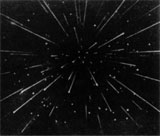
For this reason, the best viewing time for a meteor shower is generally slightly before dawn - a compromise between the maximum number of meteors available for viewing and the brightening sky, which makes them harder to see. The Sun will be just clearing the eastern horizon. When the moving radiant is at the highest point, it will reach the observer's sky that night.

See IMO Meteor Shower Calendar 2017 ( International Meteor Organization) for maps of drifting "fixed points." The radiant also moves slightly from night to night against the background stars (radiant drift) due to the Earth moving in its orbit around the Sun. This "fixed point" slowly moves across the sky during the night due to the Earth turning on its axis, the same reason the stars appear to slowly march across the sky. Meteor showers are normally named after the constellation from which the meteors appear to originate. This radiant point is caused by the effect of perspective, similar to parallel railroad tracks converging at a single vanishing point on the horizon. Radiant point īecause meteor shower particles are all traveling in parallel paths and at the same velocity, they will appear to an observer below to radiate away from a single point in the sky.
#Meteoroid wikipedia update
Jérémie Vaubaillon continues to update predictions based on observations each year for the Institut de Mécanique Céleste et de Calcul des Éphémérides (IMCCE). In 2006 Jenniskens published predictions for future dust trail encounters covering the next 50 years. McNaught, David Asher, and Finland's Esko Lyytinen were the first to apply this method in the West. In anticipation of the 1999 Leonid storm, Robert H. In 1995, Peter Jenniskens predicted the 1995 Alpha Monocerotids outburst from dust trails. Reznikov of Kazan State University first correctly identified the years when dust was released which was responsible for several past Leonid meteor storms. This showed that the meteoroids are mostly behind and outside the path of the comet, but paths of the Earth through the cloud of particles resulting in powerful storms were very near paths of nearly no activity. It showed relative positions of the Earth and Tempel-Tuttle and marks where Earth encountered dense dust.

A graph from it was adapted and re-published in Sky and Telescope. Yeomans of the Jet Propulsion Laboratory reviewed the history of meteor showers for the Leonids and the history of the dynamic orbit of Comet Tempel-Tuttle. Although the absence of meteor storms that season confirmed the calculations, the advance of much better computing tools was needed to arrive at reliable predictions. The same results were independently arrived at by Adolf Berberich of the Königliches Astronomisches Rechen Institut (Royal Astronomical Computation Institute) in Berlin, Germany. Meteor storms were expected, but the final calculations showed that most of the dust would be far inside Earth's orbit. They studied the dust ejected in 1866 by comet 55P/Tempel-Tuttle before the anticipated Leonid shower return of 18. In the 1890s, Irish astronomer George Johnstone Stoney (1826–1911) and British astronomer Arthur Matthew Weld Downing (1850–1917) were the first to attempt to calculate the position of the dust at Earth's orbit. Meteors were conceived as an atmospheric phenomenon by many scientists ( Alexander von Humboldt, Adolphe Quetelet, Julius Schmidt) until the Italian astronomer Giovanni Schiaparelli ascertained the relation between meteors and comets in his work "Notes upon the astronomical theory of the falling stars" ( 1867). The actual nature of meteors was still debated during the 19th century. Work continued, yet coming to understand the annual nature of showers though the occurrences of storms perplexed researchers. He speculated the meteors had originated from a cloud of particles in space. He noted the shower was of short duration and was not seen in Europe, and that the meteors radiated from a point in the constellation of Leo. After spending the last weeks of 1833 collecting information, he presented his findings in January 1834 to the American Journal of Science and Arts, published in January–April 1834, and January 1836. American Denison Olmsted (1791–1859) explained the event most accurately. One estimate is a peak rate of over one hundred thousand meteors an hour, but another, done as the storm abated, estimated more than two hundred thousand meteors during the 9 hours of the storm, over the entire region of North America east of the Rocky Mountains.

In the modern era, the first great meteor storm was the Leonids of November 1833. A meteor shower in August 1583 was recorded in the Timbuktu manuscripts.


 0 kommentar(er)
0 kommentar(er)
